Farming
Preamble
One of the members of our group, Sharon, is taking the lead on revitalizing the soil on our 3rd parcel of land – that’s the parcel bordering the Puyallup River that’s zoned for agriculture only. The land has been conventionally farmed for many decades and the soil is largely devoid of carbon and nutrients.
Sharon is a lifelong gardener and has been active in the Seattle P Patch program for 25+ years. In 2022, she took a WSU class called “Whole Farm Planning” and used this 3rd parcel as the example farm for her class project. The paragraph outlined in blue below is from her final report and lists the goals for the project. For those of you who like to get into the weeds, her final 24 page(!) report from January 2023 is available by clicking here. Several details have changed with experience gained in the intervening months, but the general idea is still solid!
Whole Farm Goals – January 2023
The Whole Farm Goal is to rehabilitate a 1.7 acre parcel that will support a diverse, multicrop farm providing on-site produce for a developing cohousing community. Site improvements will include a small orchard with 3-season pollinator habitat understory immediately adjacent to a riparian buffer zone to provide additional riparian protection.
Early efforts will address 3 goals:
1) remediation of exhausted soil through no-till techniques such as cover crops, composting, and mulching, 2) begin windrow composting and cover crop improvements against the riparian edge that will eventually become a small orchard strip, and 3) determination of what crops are feasible in a USDA horticultural zone 8B with wet winters and arid summers.
After the first year dedicated to continuous cover crops on the entire site, we will experiment with small scale crops. Our plan is to start small on 25 x 50ft plots utilizing 25% of the acreage with the remaining land dedicated to a 2nd year of cover crop. Efforts will be made to incorporate organic processes but becoming organic-certified is not a goal. Sustainability is a primary farm goal with zero consumption of fossil fuels.
Basic site improvements will include a rainwater storage system for dry season irrigation, development of perennial pollinator strips, and dedicated on-site composting and hugelkulture installations. Suggested future improvements will include development of an irrigation system (possibly human-powered), installation of a hoop house to expand the growing season and building of a shed/work area to provide tool storage, a produce processing area, a long sloped roof for rainwater harvesting, and shade for workers.
Beginnings - Jan 2023
An Agricultural Resource specialist from the Pierce County Conservation District has visited our site twice. She provided valuable information regarding available resources from the county. Separately, Sharon ran a quick-and-dirty soil suspension test – literally just shaking up some soil in water. The idea is that the organic matter ‘good stuff’ floats, while the inorganic silt, sand, and clay sinks. Having lots of organic matter in the soil is good for many things, including plant health, carbon sequestration, and water retention.
The two bottles on the left of the picture are soil samples from a couple of locations on the farm. The bottle on the right is soil collected from a Seattle community P-Patch plot that has received several years of continuous soil building improvements.
Notice any difference?
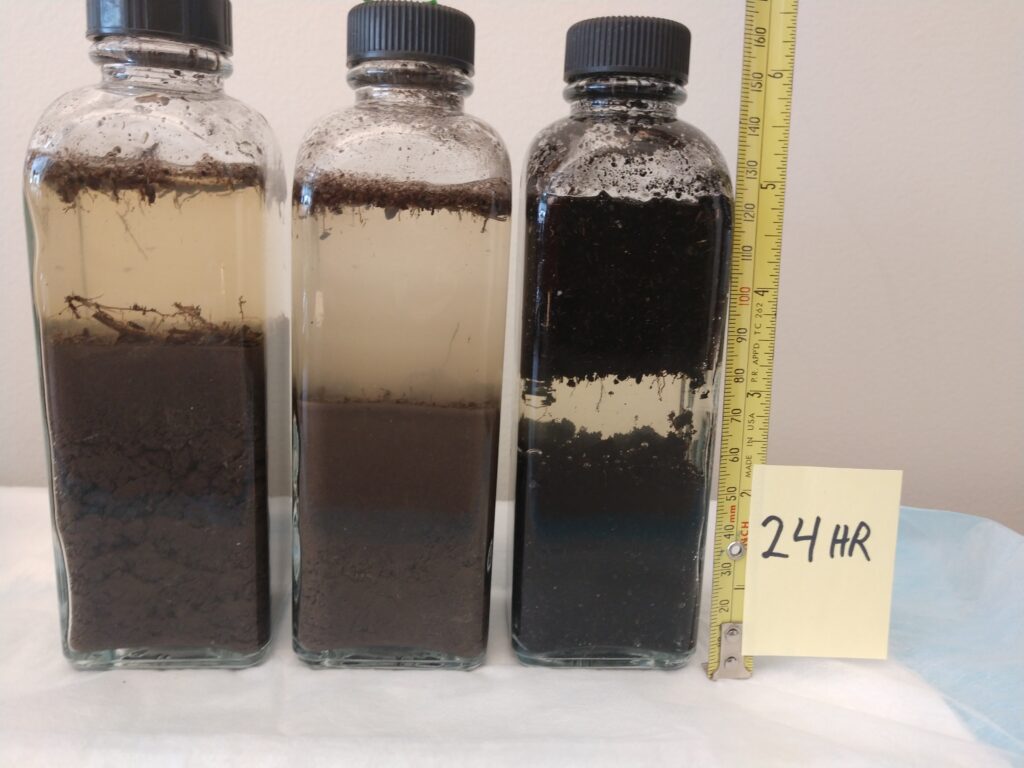
Left 2 samples from farm; right sample from seattle
First Work Party - Mar 2023
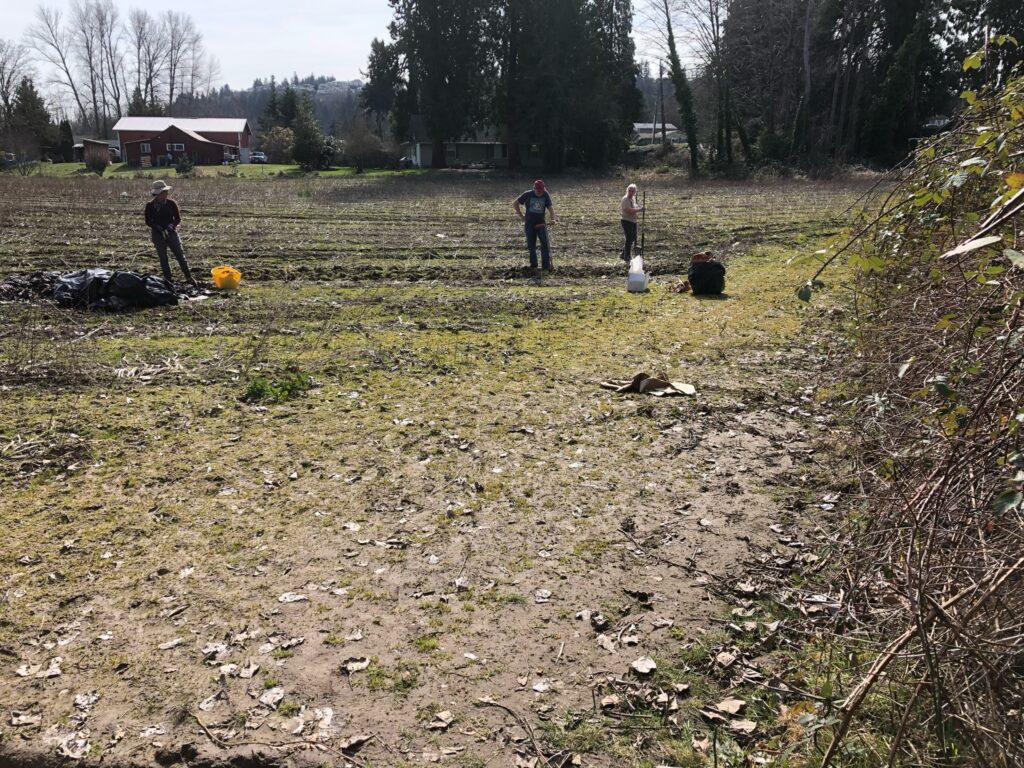
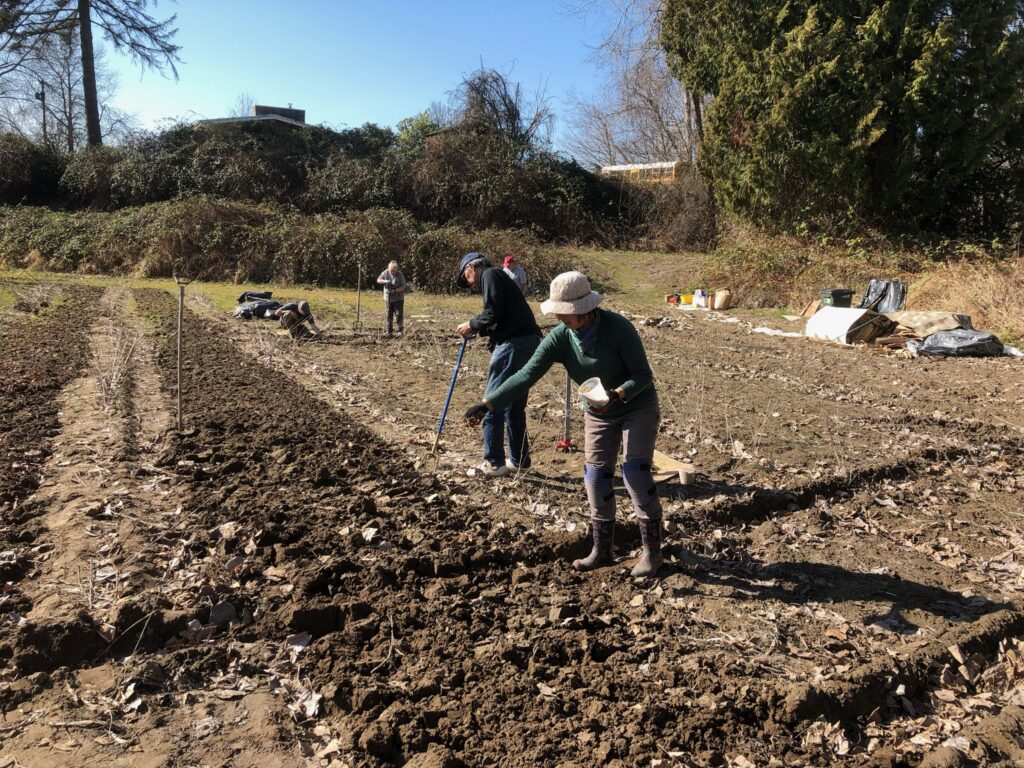
Many hands make for lighter work – but 2 acres is still LOTS of dirt to keep up with.
Especially since we’re trying to reduce our carbon footprint by not using any diesel powered farm equipment.
Turns out kids like riding on broad forks while their parents are trying to work the fields – who knew?
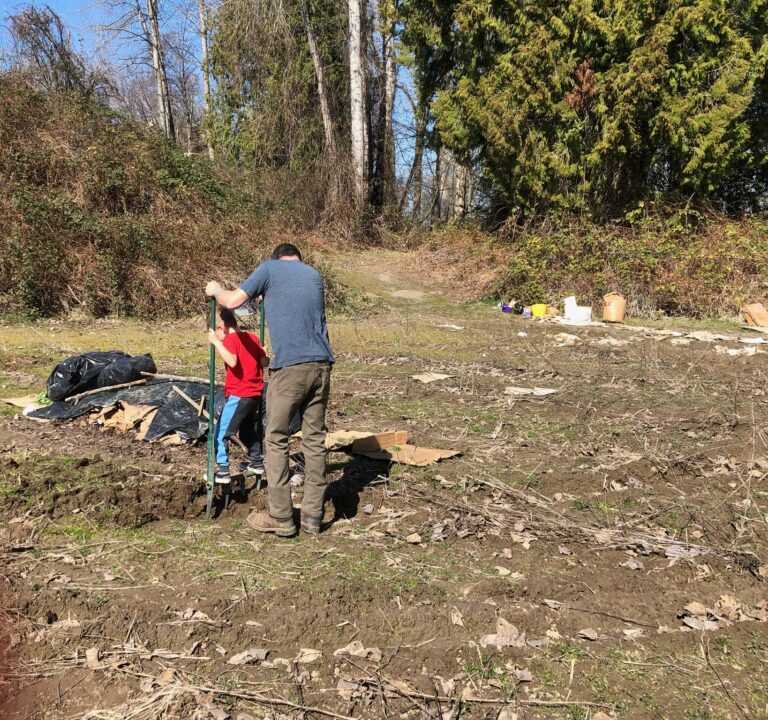
Second work party - May 2023
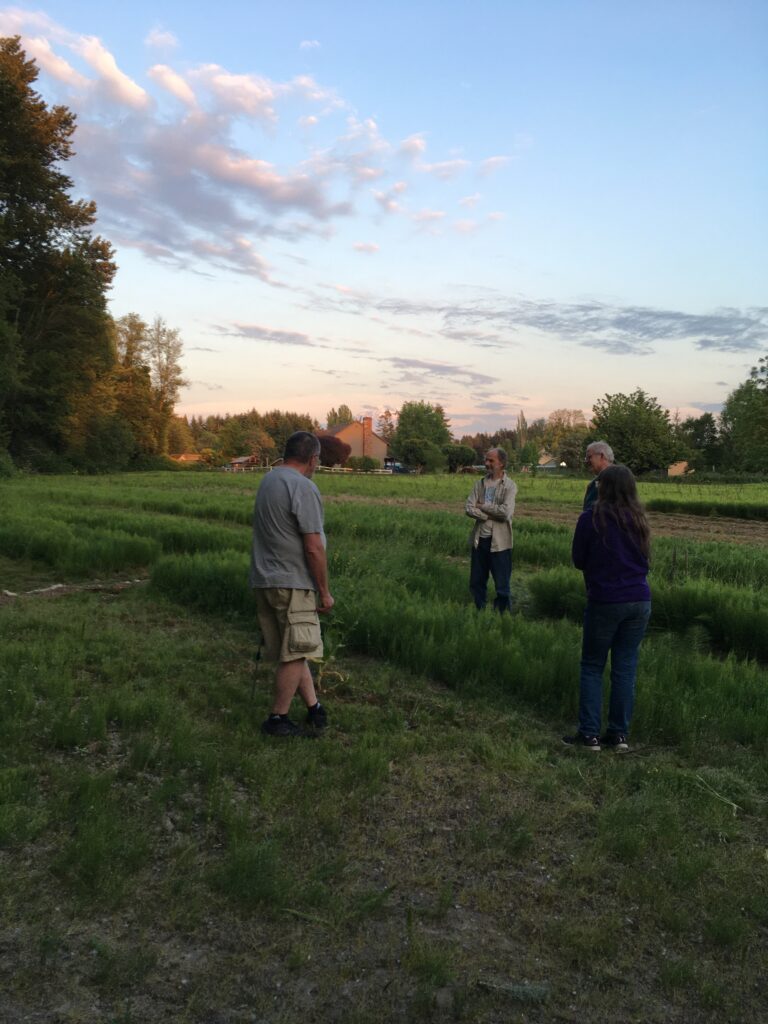
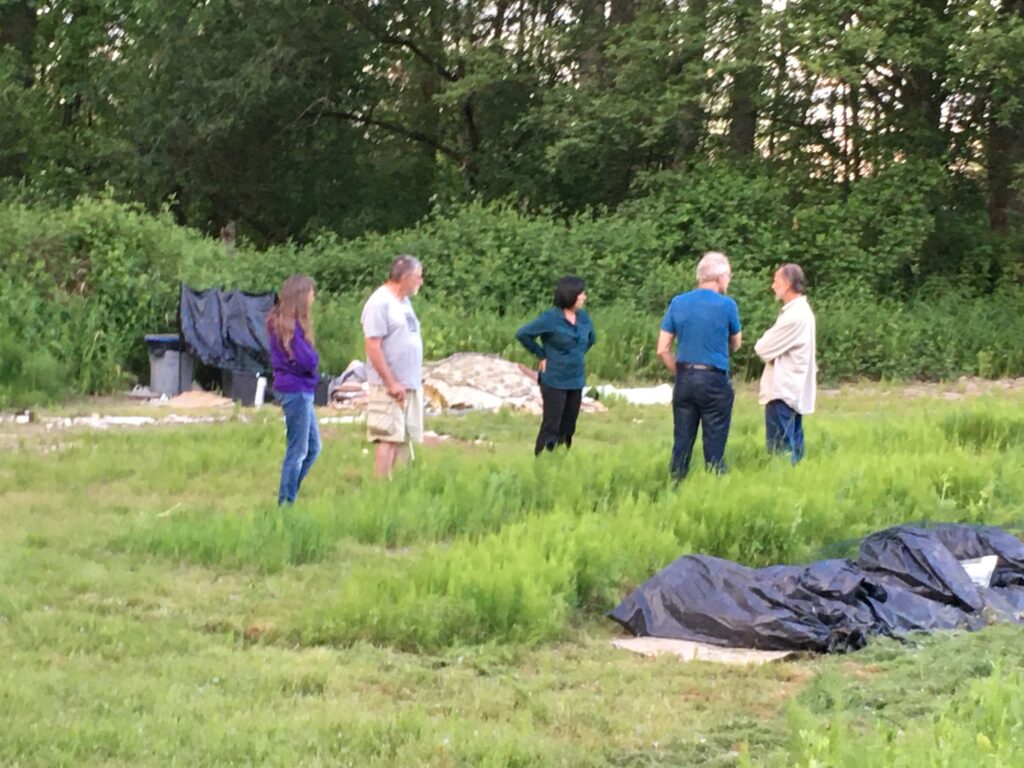
The Horsetail Ferns have taken over the lower field! This plant is a survivor of ancient lineage, sometimes called a ‘living fossil’. It’s known to thrive in poor soil where other plants fear to tread. Mowing them down will provide some extra mulch and carbon for the depleted soil, and we’ll hope to out-compete them with cover crops going forward.
first season progress report - Aug 2023
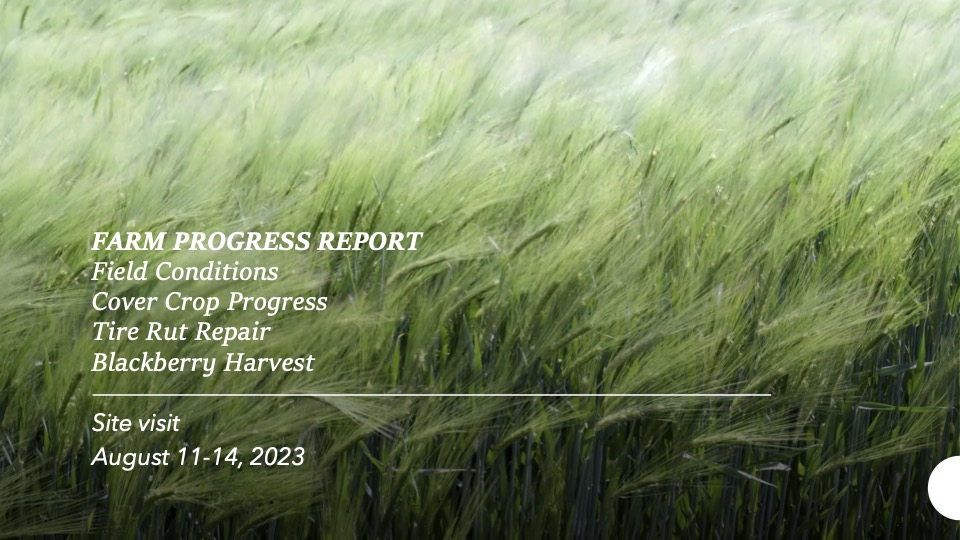
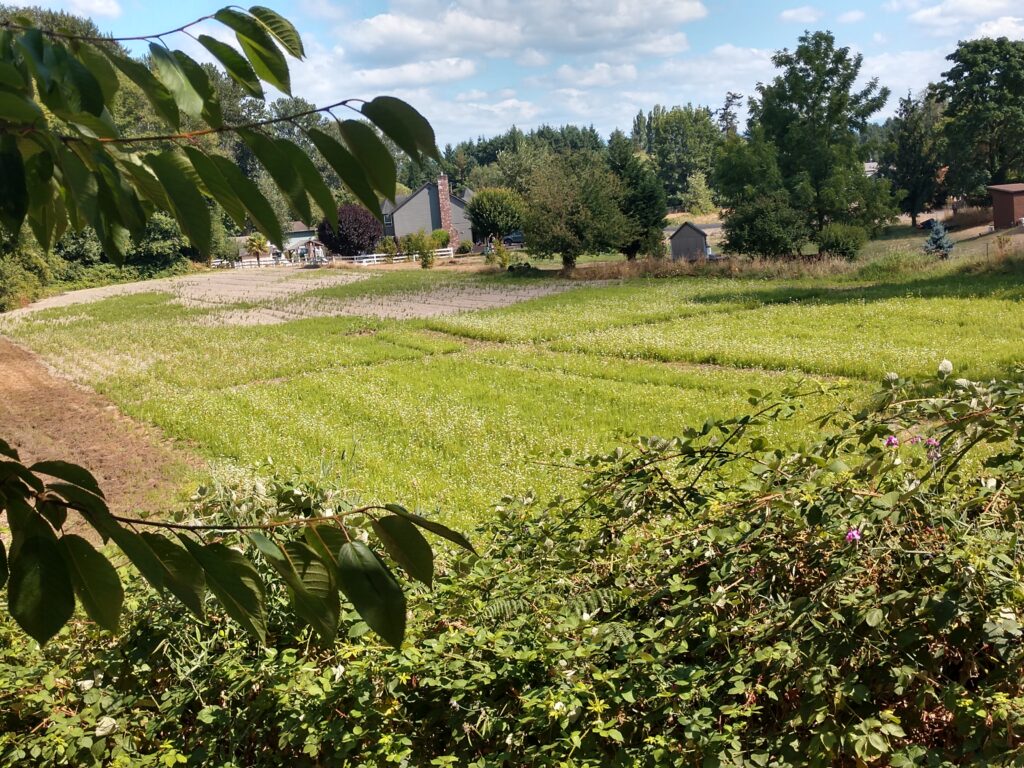
Main Field – View from the upper path looking SouthEast
The brown strip on the left is a large swath of mowed horsetail, cured and creating a dry mulch layer. The SE corner of the field was too dry to establish a summer cover crop. Green growth is horsetail. This section will be heavily seeded with winter cover crops to take advantage of the rainy season. The remainder of the field is mixed cover crop with regrowth of horsetail.
Paths are being mowed into the field to create 6-8 large plots that can be individually managed according to the soil conditions.
The last rainfall was August 8th with approximately 1/10 of an inch.
The cover crop is a variety of types:
Grassy blades are sorghum Sudan grass which helps break compaction and contributes lots of organic matter.
Blue flowers are Lacey phacelia which attracts pollinators.
White flowers are buckwheat which attracts pollinators and grows quickly to provide a nurse crop for slower germinators. Dropped mature seeds will automatically replant the next round of buckwheat.
Viney growth on the right is the mature tops of tillage radish, a compaction breaker and organic matter contributor.
Bottom shows weed sprouting of horsetail regrowth and red pigweed.
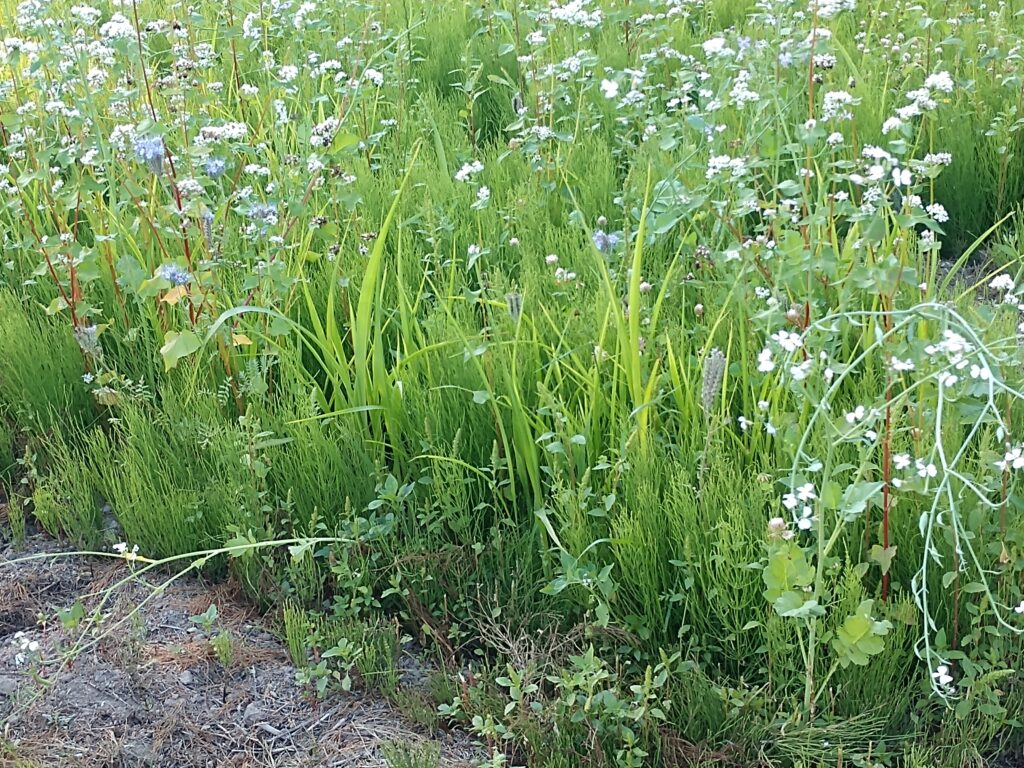
One view of the cover crop
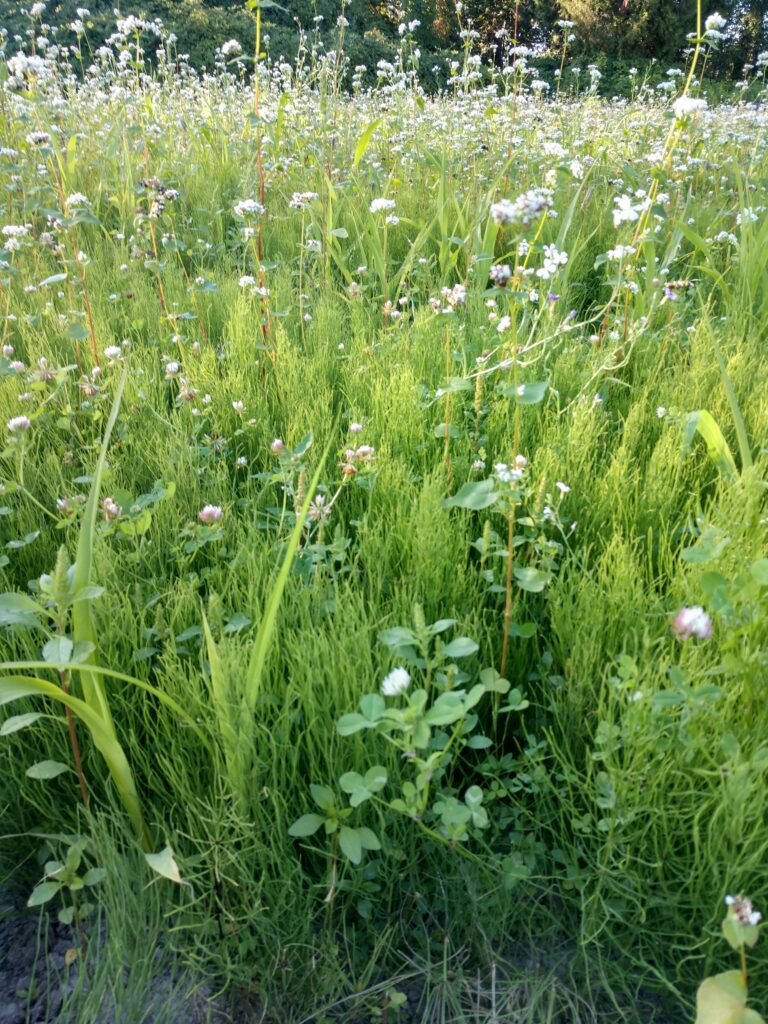
Another view of the cover crop
This shows how well the buckwheat established over the entire planting area.
Short white flowers are baluns clover which contributes organic matter and establishes soil-based nitrogen-fixing bacteria through inoculated seeds.
Eradicating horsetail and pigweed will be a long-term effort. However, in the first year these weeds are providing shade and ground cover which helps establish the cover crop and protects the ground surface from evaporation caused by wind and sun.
Through prolonged cover crop cultivation, it may be possible to out compete the worst of the weed problem.
Super Sioux is an indeterminate beefsteak type tomato, 75 days to maturity post transplanting. This tomato was selected for it’s ability to thrive under dry conditions.
It’s a very bushy plant that required some pruning to promote air circulation throughout the vine.
Tomatoes are heavily mulched and receive light water with each visit. Overwatering can lead to fast water uptake and cracking of fruit so we kept things on the drier side.
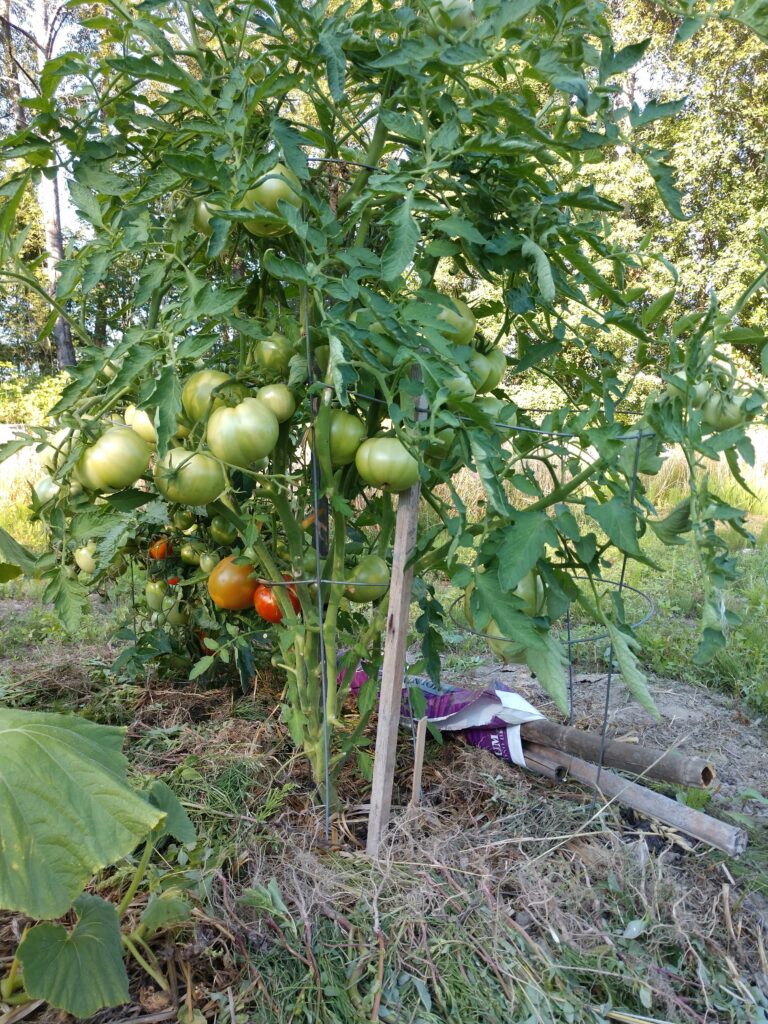
Tomato Experiment #1: Super Sioux
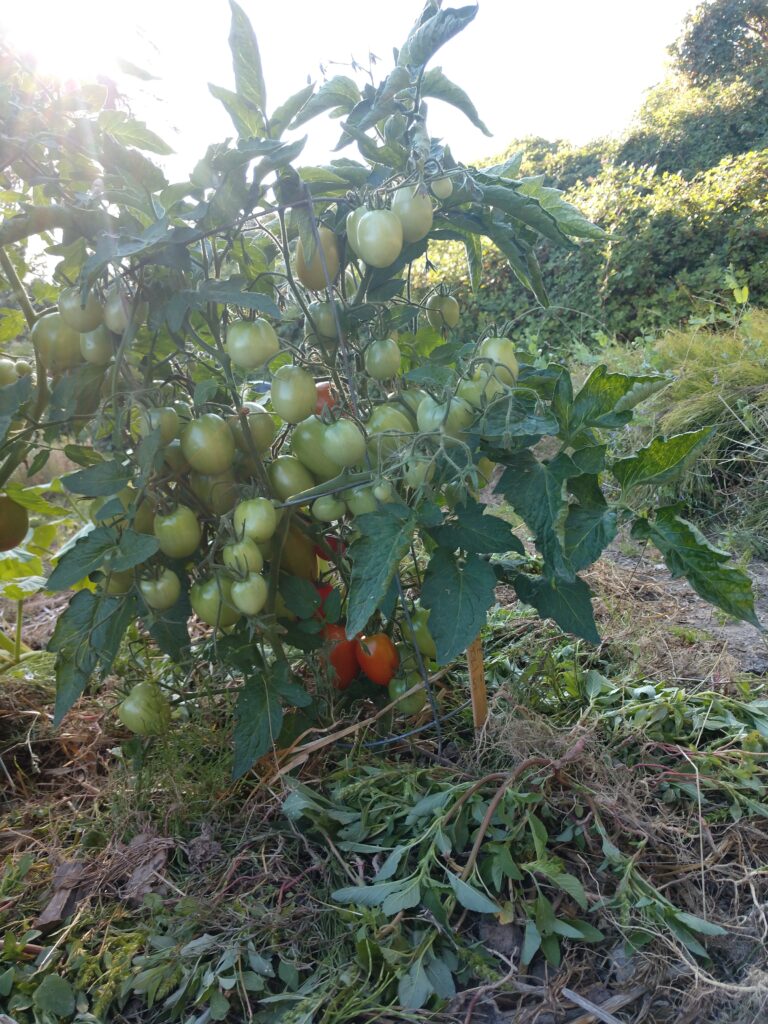
Tomato Experiment #2: Little Napoli
Little Napoli is a determinate Roma (paste) type tomato; 70 days to maturity post transplant. Fruit will be harvestable over a period of 3-4 weeks and then the plant is done for the year. It’s a good choice for canning and is somewhat tolerant of dry conditions.
The mulch layer consists of pulled horsetail and pigweed. The bed prep consisted of half of a winter compost heap dug into normal field dirt, creating a moderately raised 4ft x 8ft mound. The compost supplement helps the bed maintain a consistent moisture level between light waterings.
Prescott Fond Blanc melons were transplanted over Memorial Day, but didn’t establish. However, the supplemental compost contained lots of dead jack-o-lanterns and we ended up with several volunteer pumpkin vines.
Sharon selected the strongest two vines to utilize the remainder of the raised bed. The droopy leaves are the vine’s way of preserving moisture and is seen late in the day. One pumpkin has set (a little smaller than a soccer ball) and additional fruits can be expected. Mulch is layered horsetail and pigweed. Watering schedule is the same as tomatoes.
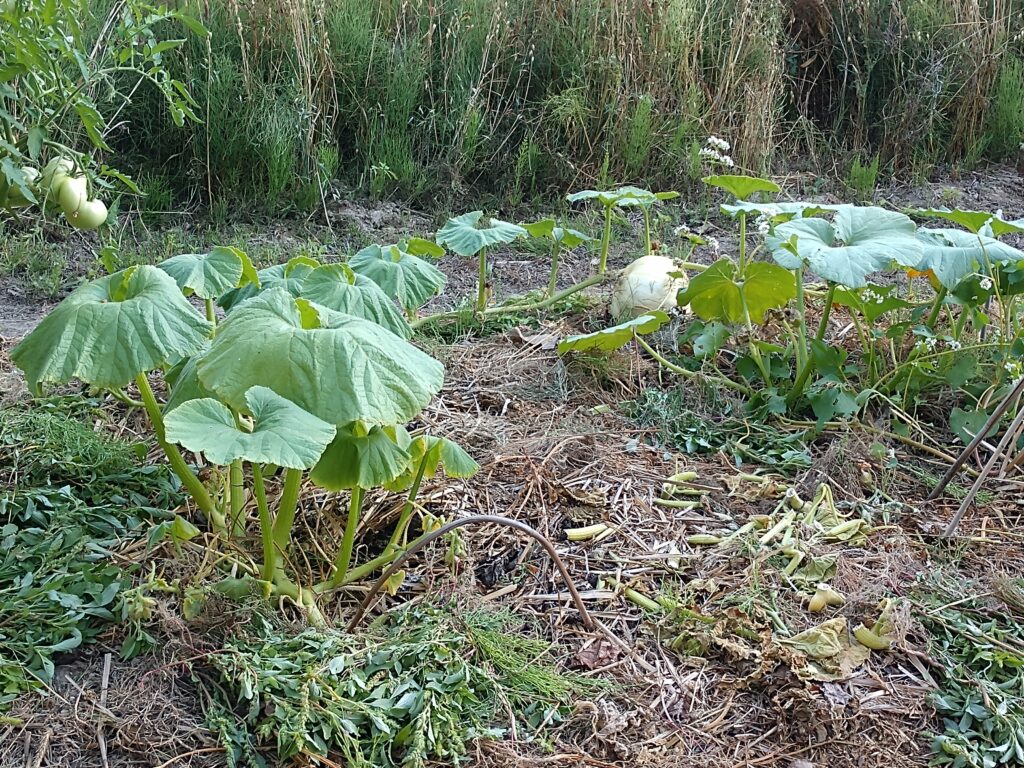
Melon Experiment Failure
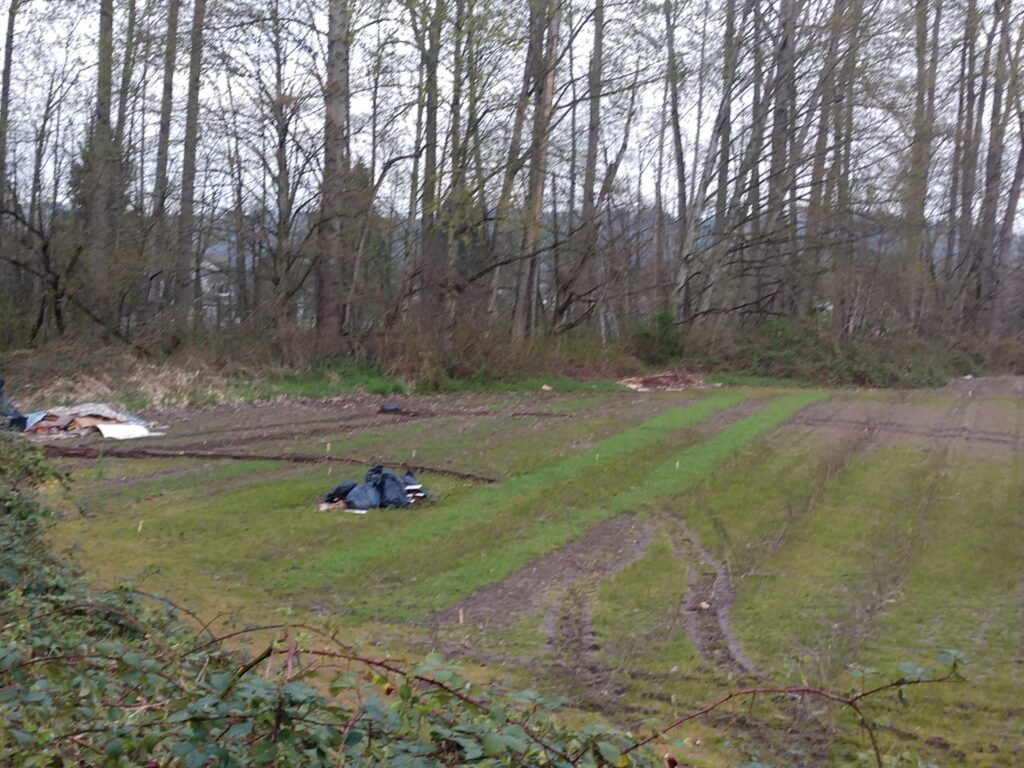
Problem Solving: Tire ruts in the field
A truck was driven over the saturated field during the winter leaving several sets of deep tire ruts.
How to repair this damage in the NW corner of the field?
This photo was taken in April 2023 and you can see the initial growth of the oats and peas sown in March. The black plastic is a compost heap, tarped to protect it from heavy winer rains.
Beyond the treeline are wetlands bordering the Puyallup River.
Over the summer, the ruts have dehydrated leaving compacted channels that are 9-12 inches deep and wide.
They are hard to see and it’s easy to roll your ankle into a rut if you’re not careful!
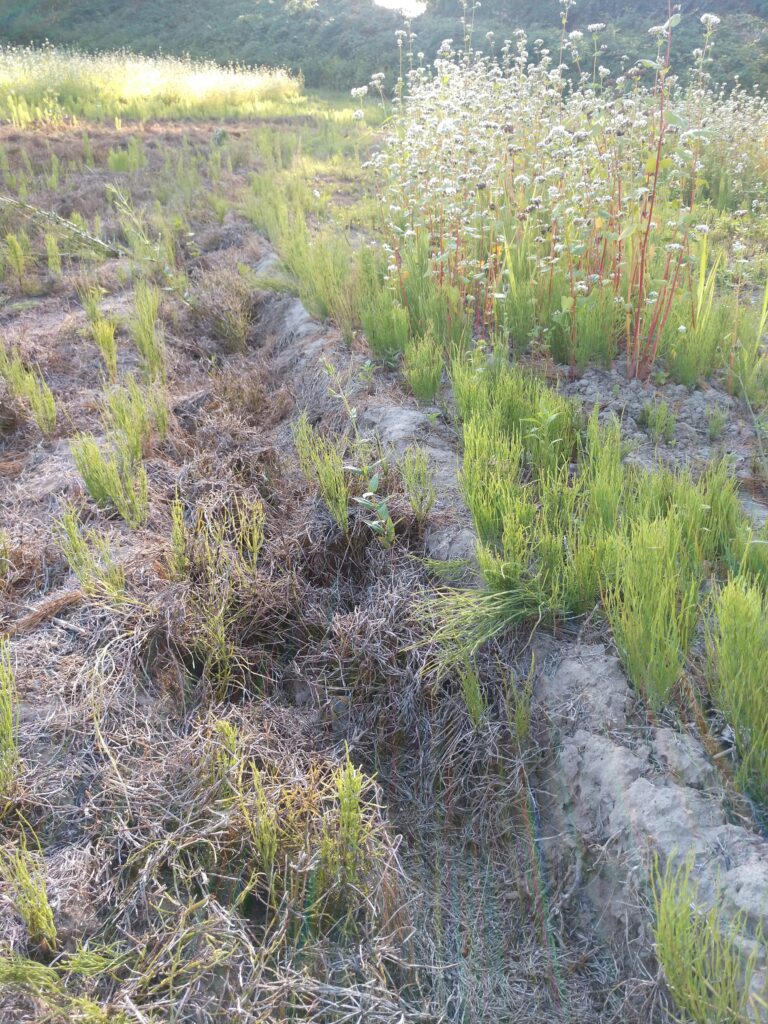
Tire ruts in August
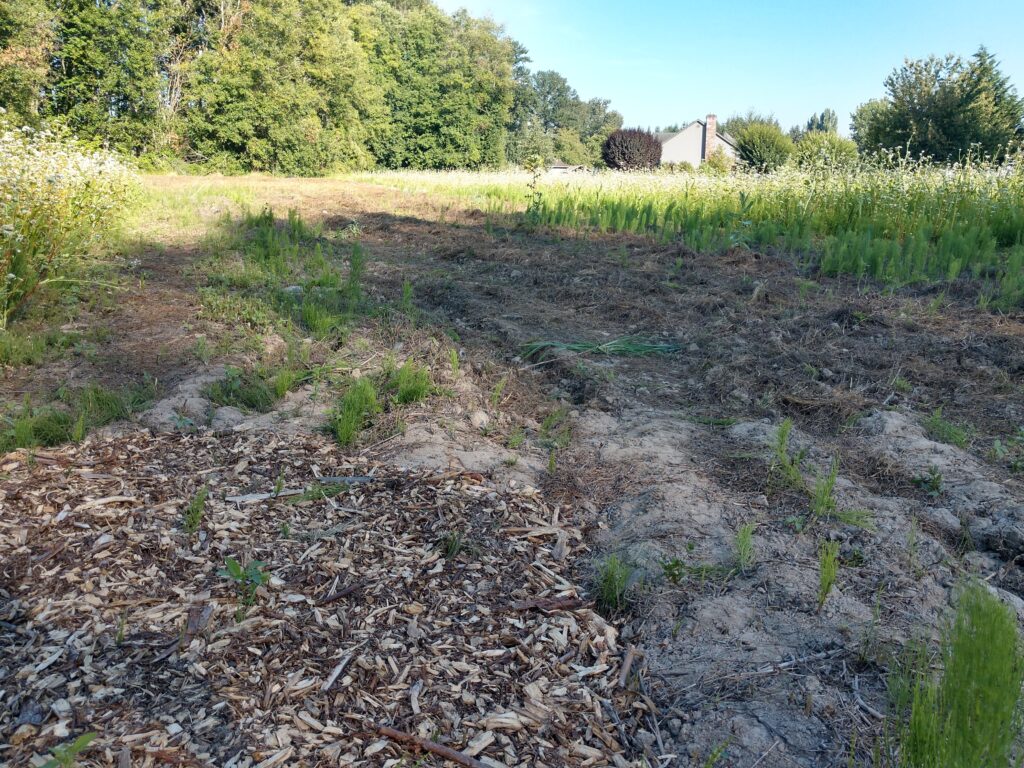
Solution #1: Repair
Some of the ruts are parallel, so the outer edges can be broad forked leaving a cambered strip that can be chipped and used as a foot path (bottom left).
This path (under construction) will help define the borders of the NW demonstration garden.
Shallower ruts can be broad forked, leveled, and sown with cover crop. (Right side, sown 8/14)
Some ruts are against the North riparian strip where alders are naturally dropping dead branches.
By filling the ruts with chopped blackberry vines, shredded cardboard, and dried leafy branches, a compostable layer can be built in the trenches.
These trenches will naturally fill with winter rains draining from the field and create a water bank.
Trenches filled with composted debris topped with chopped downed branches can create the subsurface layer of a developing hugelkulture mound.
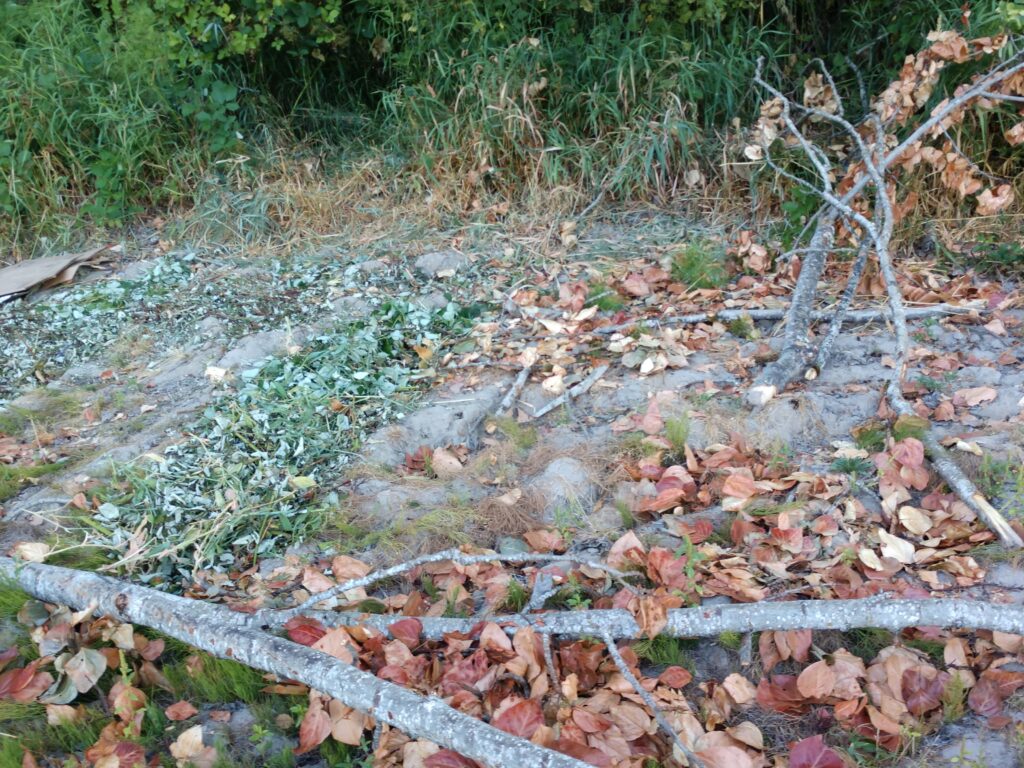
Solution #2: Treat Ruts as Swales and Eventual Hugelkulture sites
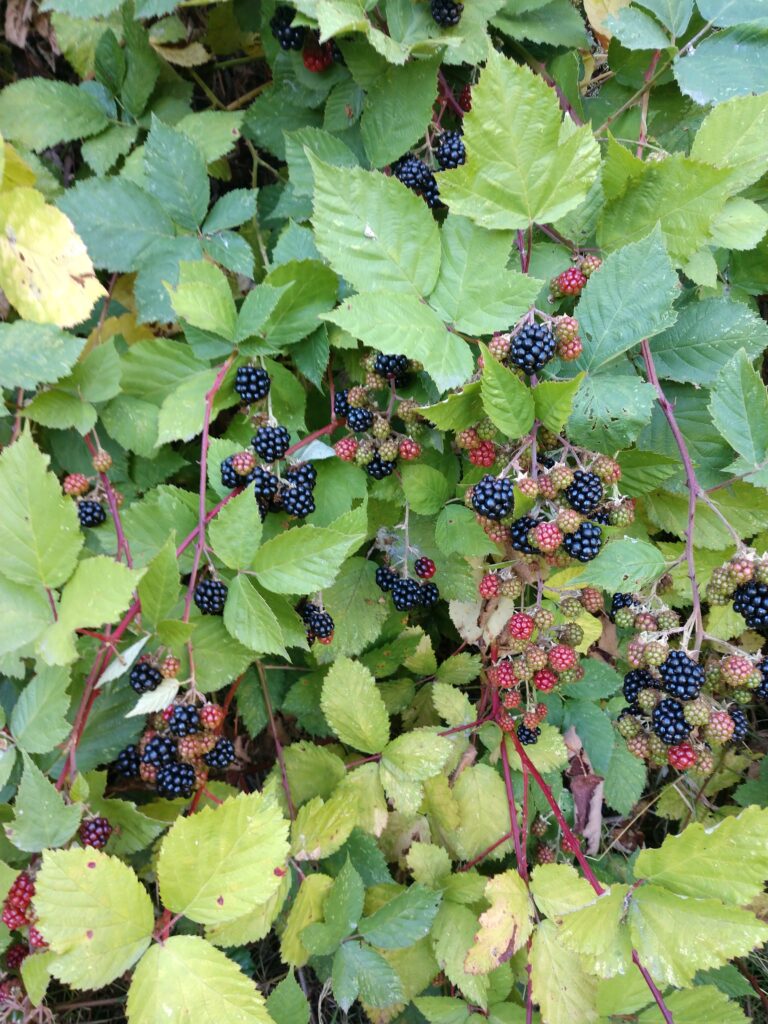
Blackberry patches are common on the farm…
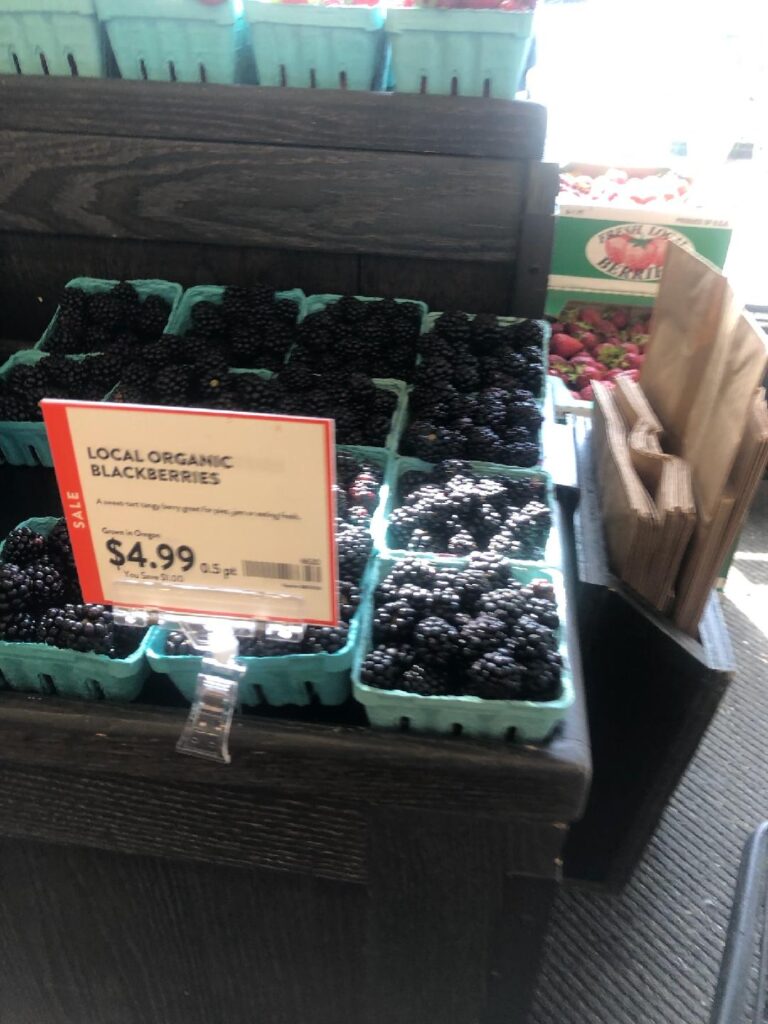
Tasty, but pricy!
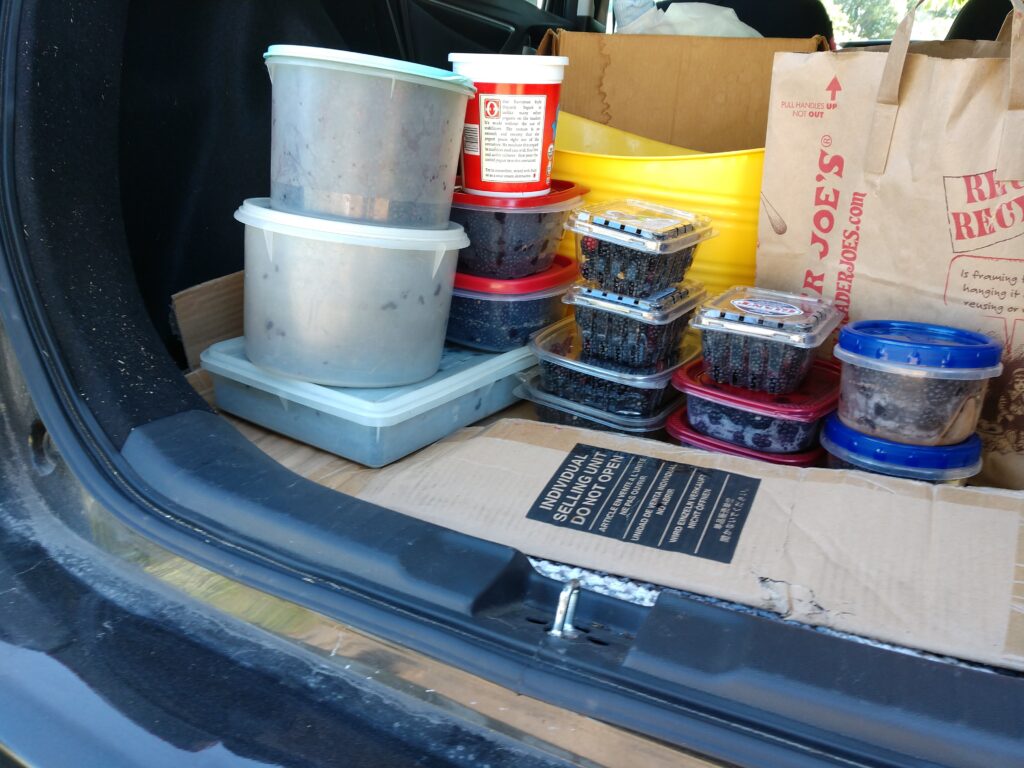
Any container will do…
In just under 3 hours, Sharon harvested 18 pounds of prime blackberries.
This was a fraction of the ripe berries that were easily picked from the edges of the briar patch.
Nine pounds went to a neighbor of Sharon’s who loves to make jam. The remaining nine pounds were donated to a food bank recipient through Sharons P Patch Community Garden in Seattle. The blackberries should be producing for several weeks and there are several patches in morning shade for easy harvests.
Doing the math: two half pints of blackberries weigh one pound. 18 pounds of blackberries would go for $180 at PCC.
Makes you think….
FARM PROGRESS REPORT NOVEMBER 15, 2023
END OF MAIN GROWING SEASON
LATE SEASON FIELD PREP
DORMANT CROPS
THREE FLAVORS OF COMPOST
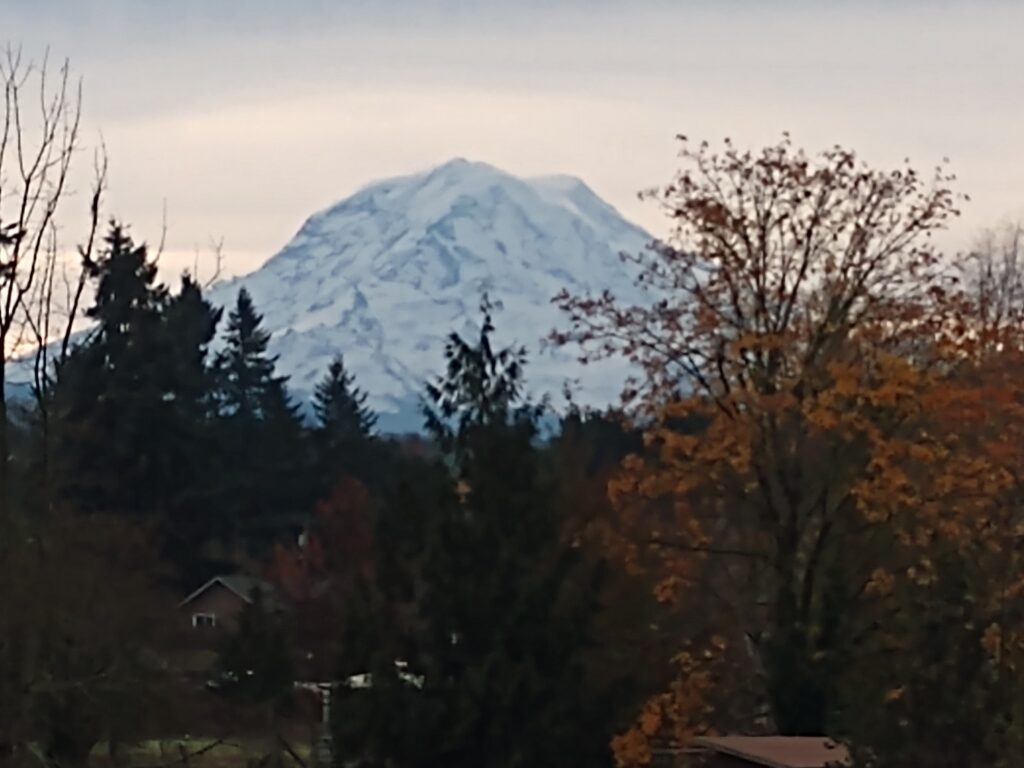
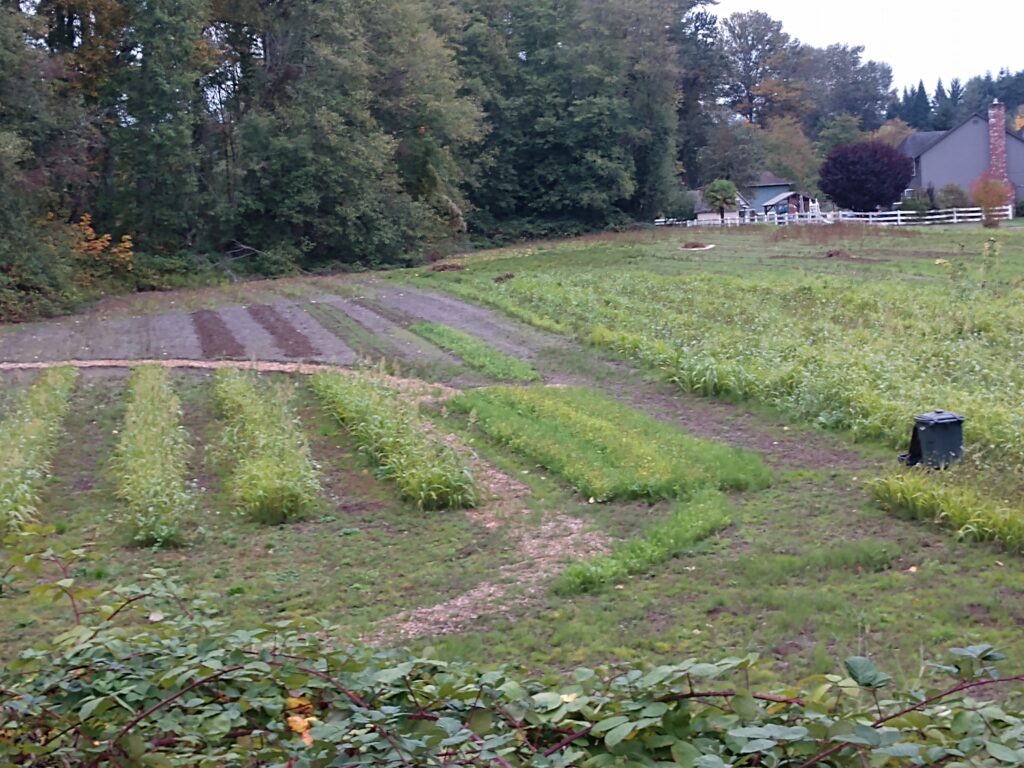
Mid October Field
Despite drought, the summer cover crop performed well.
Sudan grass reached shoulder height, tillage radish produced lots of seed pods, and buckwheat produced lots of seeds ensuring a good volunteer crop next year
Balansa clover and alfalfa were hard to tell apart but there was dense clover-like growth throughout the plots.
Horsetail continued to be a problem but the cover crop persisted in tandem.
FIRST HARD FROST October 29
Sudan grass and second growth buckwheat has no tolerance for cold so it has clearly frost-killed. Frost has also wilted much of the remaining horsetail. Tillage radish is frost-tolerant so it persists.
Mid September to early November is the window for sowing cold-tolerant winter cover crop. The winter mix consists of cereal rye (rapid ground cover with deep fibrous roots), common vetch (nitrogen fixation and tilth contributions), crimson clover (nutrient scavenger and erosion prevention), and more tillage radish (compaction buster). Sowing is focused on areas that missed out on summer cover crop.
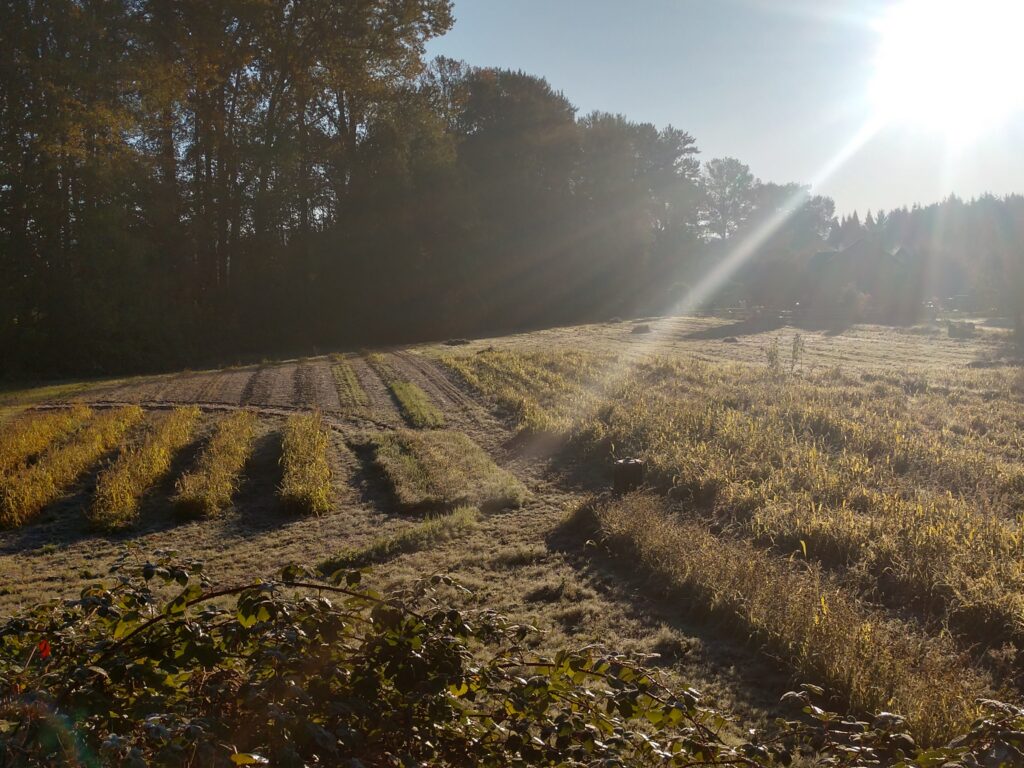
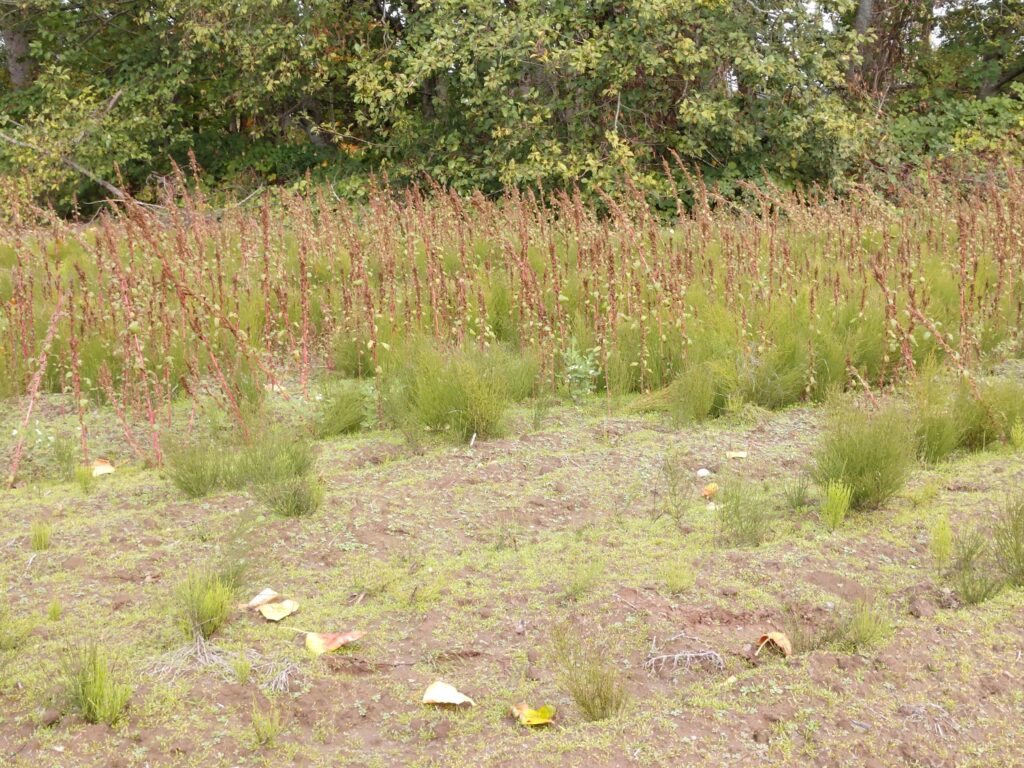
WEED CONTROL
In addition to horsetail, the site also hosted large swaths of red pigweed. This was especially dense in the east field where its deep taproot enabled it to thrive in poor soil.
Each stalk is capable of shedding hundreds of seeds and hand pulling is preferred to herbicide spraying for control. Due to the huge volume of pigweed, pulled stalks were dumped on large cardboard pallets and left to winter decay. Seeds can remain viable for several years so the piles can’t be moved and will serve as plots of surface mulch.
It will take several years to reduce the soil seed bank so there will be an ongoing need for hand pulling.
FINAL HARVEST
Super Sioux tomatoes performed very well and 1 plant yielded approximately 25 lbs of ripe beefsteak tomatoes. Little Napoli tomatoes also continued to yield late in the season despite being classified as a determinate type. October rains caused cracking in the late tomatoes but several pounds of undamaged green tomatoes were harvested right before frost.
Three volunteer pumpkins were harvested in time for Halloween.
While the main growing season is over, there are still many opportunities to grow crops and improve the soil during the cold, rainy season.
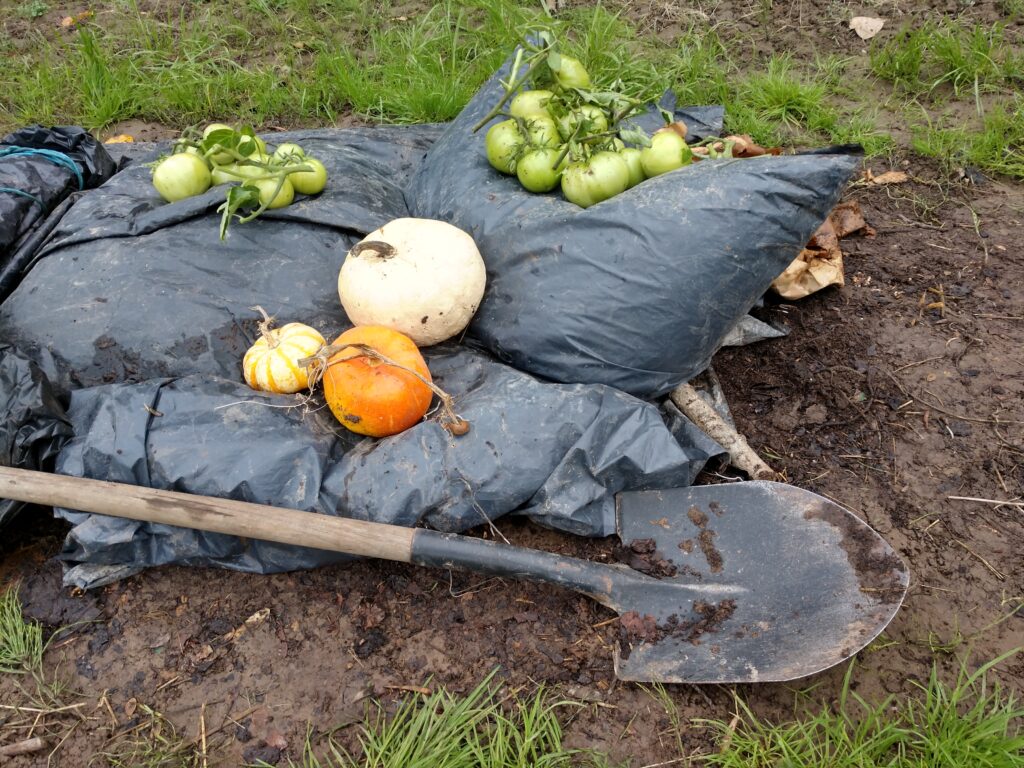
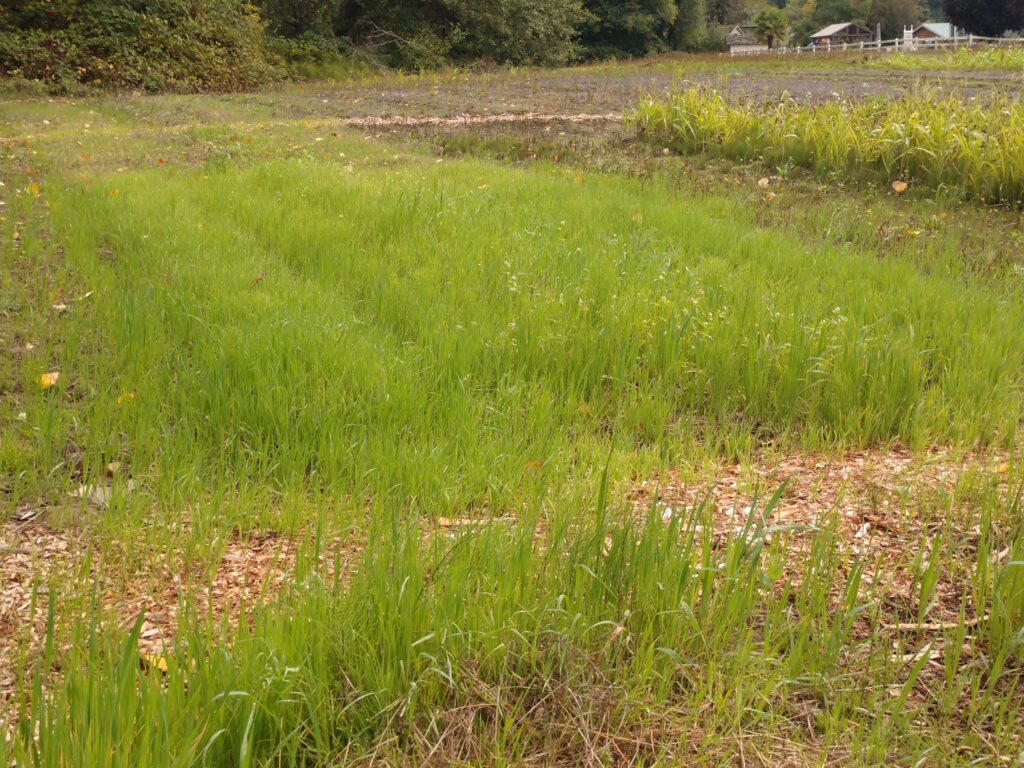
Oats/peas were mowed in August and allowed to regrow until mid September
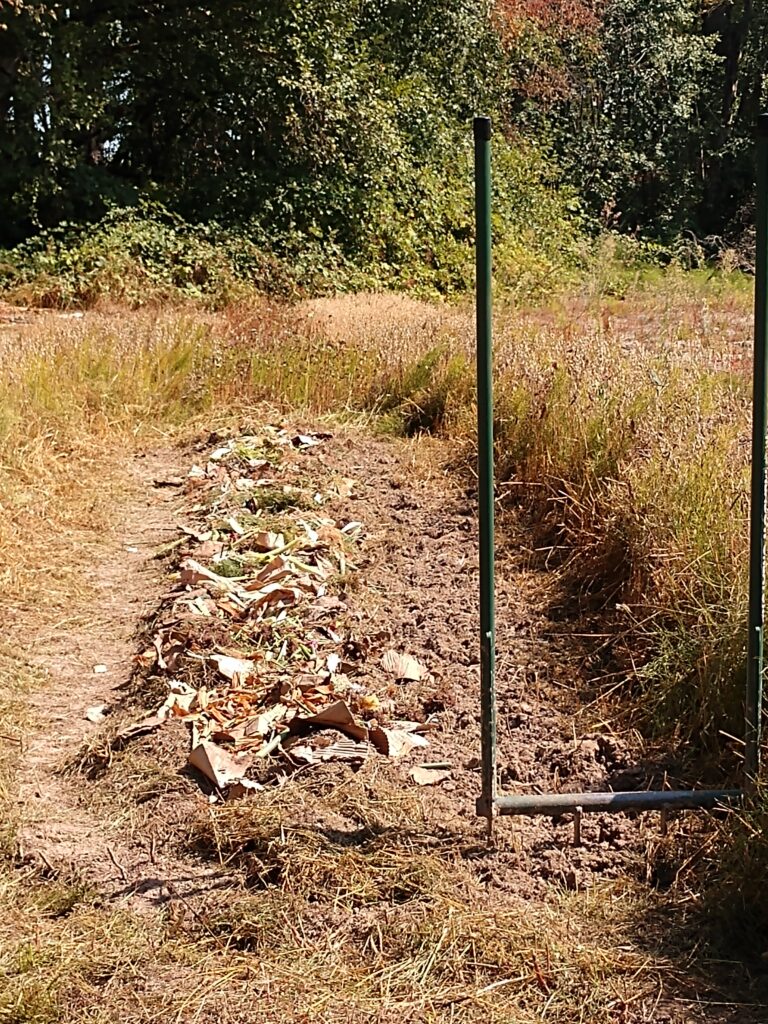
Second growth was mowed, 3 berms were formed andtrench composted with chopped cover crop
SECOND GROWTH OATS & PEAS WILL CONDITION A BED FOR FALL GARLIC
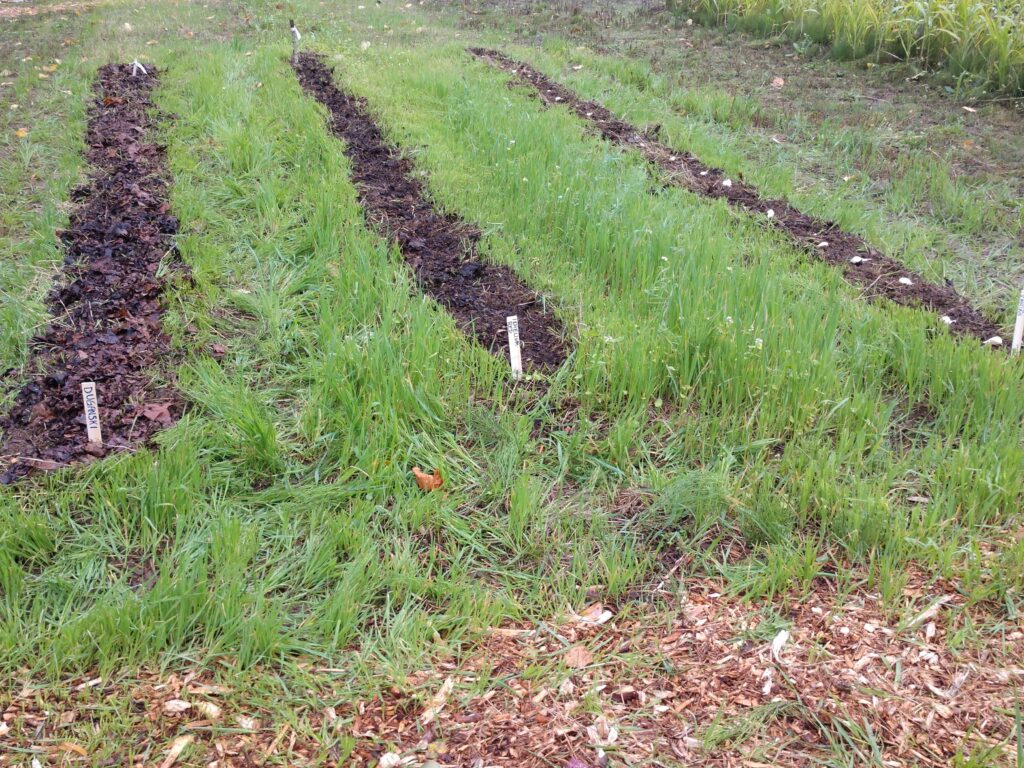
GARLIC PLANTED OCTOBER 21
The second August mowing of oats and peas sowed enough seed to produce a third volunteer crop which will provide erosion and wind protection late in the season.
Three types of garlic were sown in berms fortified with finished compost: 1) Duganski – purple hardneck; 2) Transylvanian — Romanian softneck; 3) Inchelium Red – softneck heirloom type originally found on the Colville Indian Reservation in WA state and thought to be one of the oldest cultivated varieties.
Each row received 1⁄2 lb of cloves and was well mulched with shredded leaves. Harvest will be in July 2024.
FIRST YEAR ASPARAGUS READY TO OVERWINTER
Two types of asparagus were started from seed at the Seattle community garden in spring 2023. Each planter holds ten first year crowns which will be heavily mulched with shredded leaves and allowed to overwinter.
The crowns will be transplanted to Puyallup in spring 2024. As a long-lived perennial, they will require a deep trench amended with lots of compost and an additional two years of growth to reach spear- producing age.
Millenium asparagus is reported to produce more male plants (desirable for higher yields since their energy is not spent producing fruiting seeds). Three Pound Coffee Can is an heirloom type from Seed Savers’ Exchange.
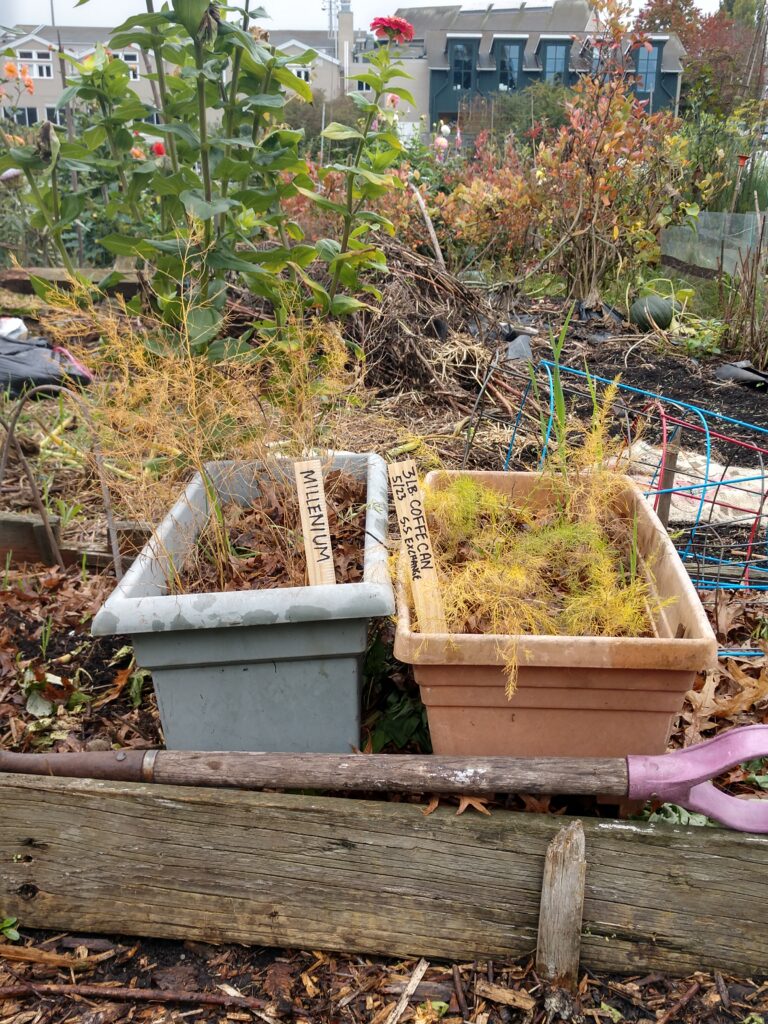
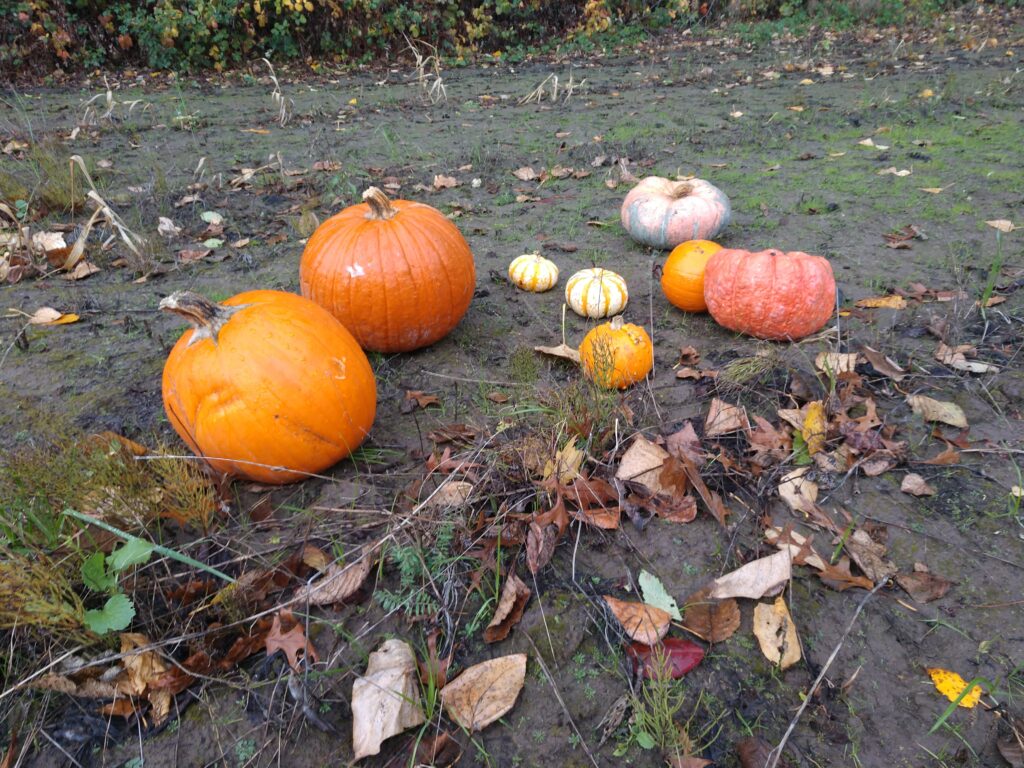
WINTER IS COMPOST SEASON
Late fall is the perfect time to begin compost because there is an abundance of compostable materials, the onset of winter freeze/thaw cycles that assist with materials breakdown, plenty of rain, and most importantly—time.
Post-Halloween, there Is an abundance of leftover ornamental and jack-o-lantern type pumpkins in addition to unlimited fallen leaves. Seed management is important to prevent mystery plants from infiltrating the compost heaps.
TRENCH COMPOSTING IS A ONE AND DONE PROCESS
Trench composting is what it sounds like: dig a trench and bury your compostables. It allows intensive soil improvement of a spot the size of a large root zone. This trench received windfall apples, chopped pumpkins, shredded leaves, and sunflower stalks. Everything was chopped and mixed well with trench soil, topped with a 6-inch layer of soil, and mulched thickly with additional shredded leaves.
Intact pumpkins create the strong possibility of volunteer pumpkins. By trench composting, Sharon may have already sown the seeds for a pumpkin patch next season.
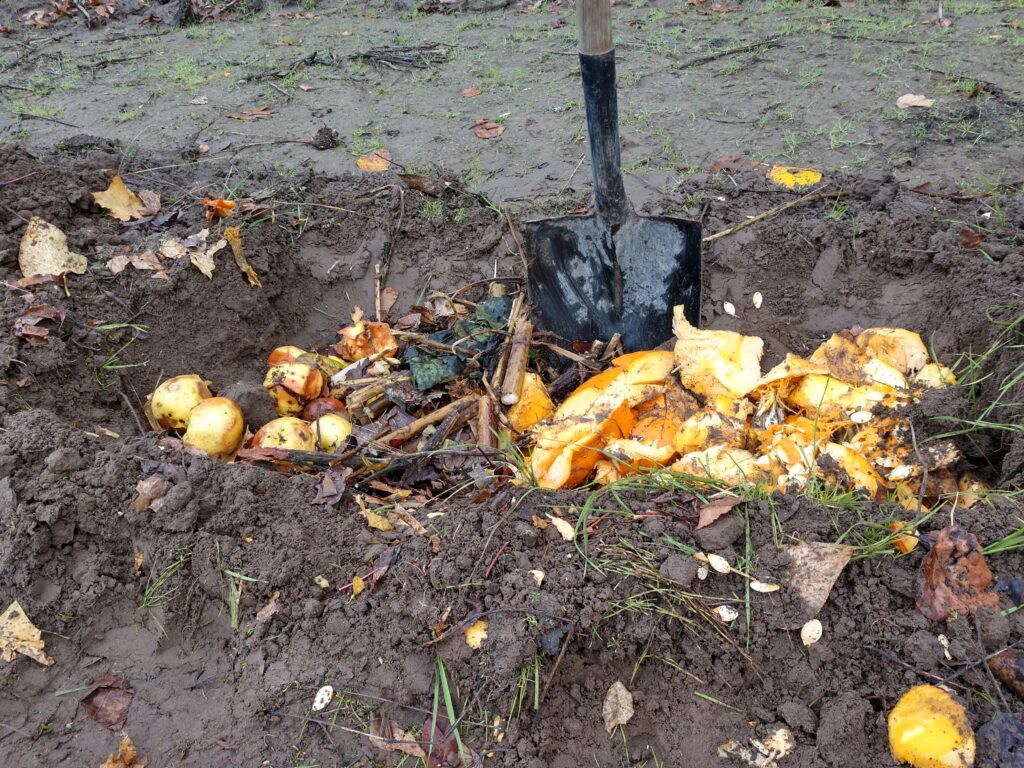
SHEET COMPOSTING IS JUST FANCY MULCHING
Roots remain in the ground, slowly decaying and simultaneously anchoring the protective stubble.
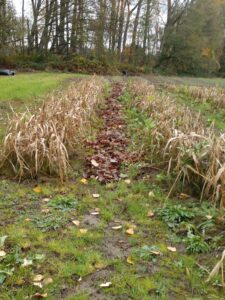
The alley between two rows of summer cover crop was loaded with maple leaves and then mowed, allowing two protective rows of stubble to remain.
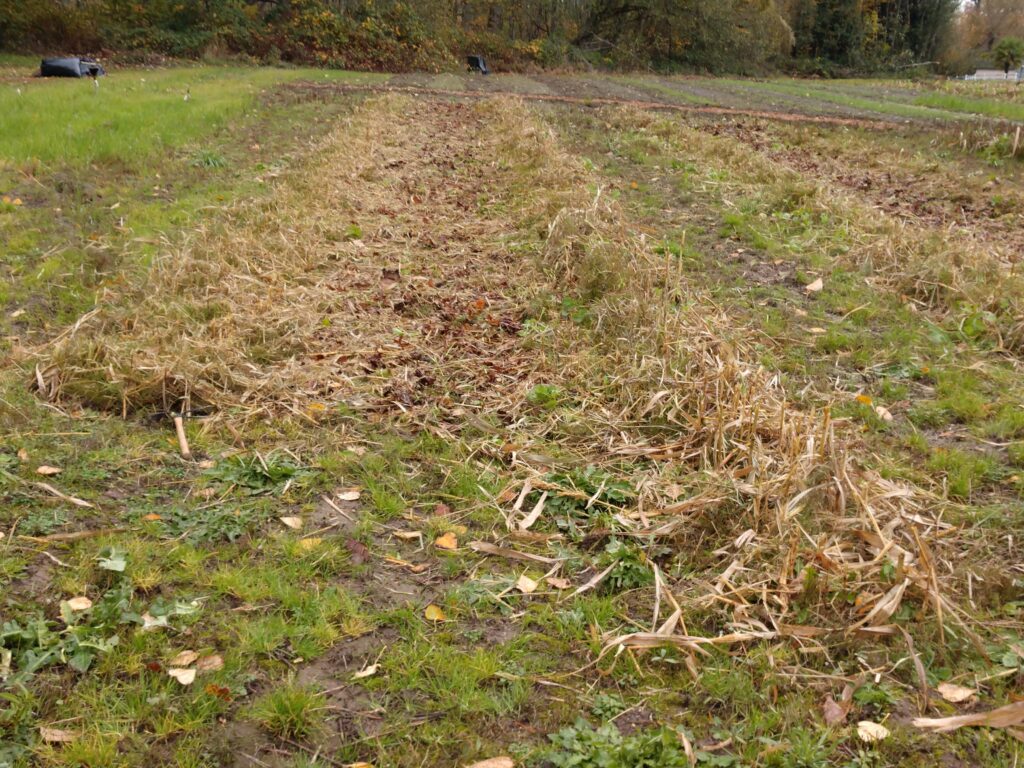
Stubble protects shredded leaves and cover crop from blowing away and marks the plot that will receive additional shredded leaves later in the season.
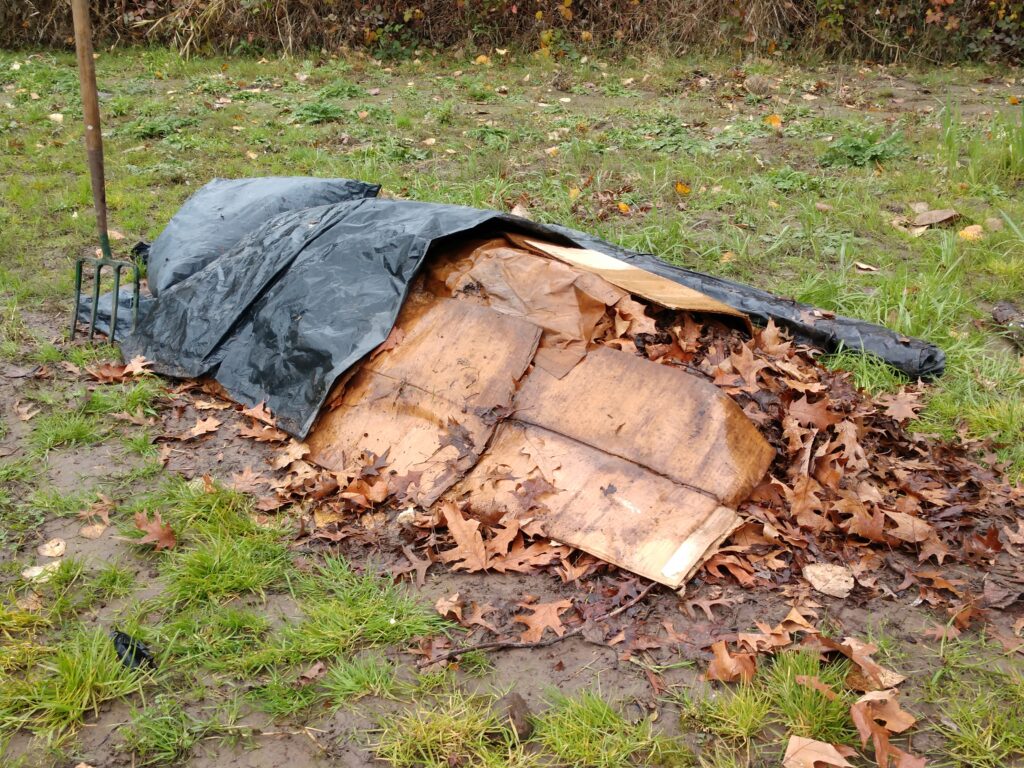
THE OLD- FASHIONED COMPOST HEAP
This is simply a large pile of mixed brown (leaves) and green (pumpkins, apples) material, turned periodically to aerate and mix, and occasionally fed. The heap is built on top of a layer of cardboard to suppress ground weeds.
Cardboard sheets help retain the shape and provide an insulating layer. The black plastic helps with heat retention and sheds winter rain, preventing the heap from becoming a soggy mess.
This heap was fed dead jack-o-lanterns which provide lots of pulp but no seeds to volunteer next spring.
WORMS LOVE CARDBOARD
Card board is basically wood pulp and glue. When wet and tarped, a damp, sticky, and warm environment is created that is very attractive to worms. Cardboard insulation helps ensure that the heap retains a non-frozen core which is where most of the worms will migrate during the coldest months.
Fun fact: Cardboard is approved for organic growing if it is brown, unwaxed, untreated, and with minimal ink (black ink only). All labels and tape must be removed and if shredded, it will break down easily in compost while providing good snuggle material for worms.
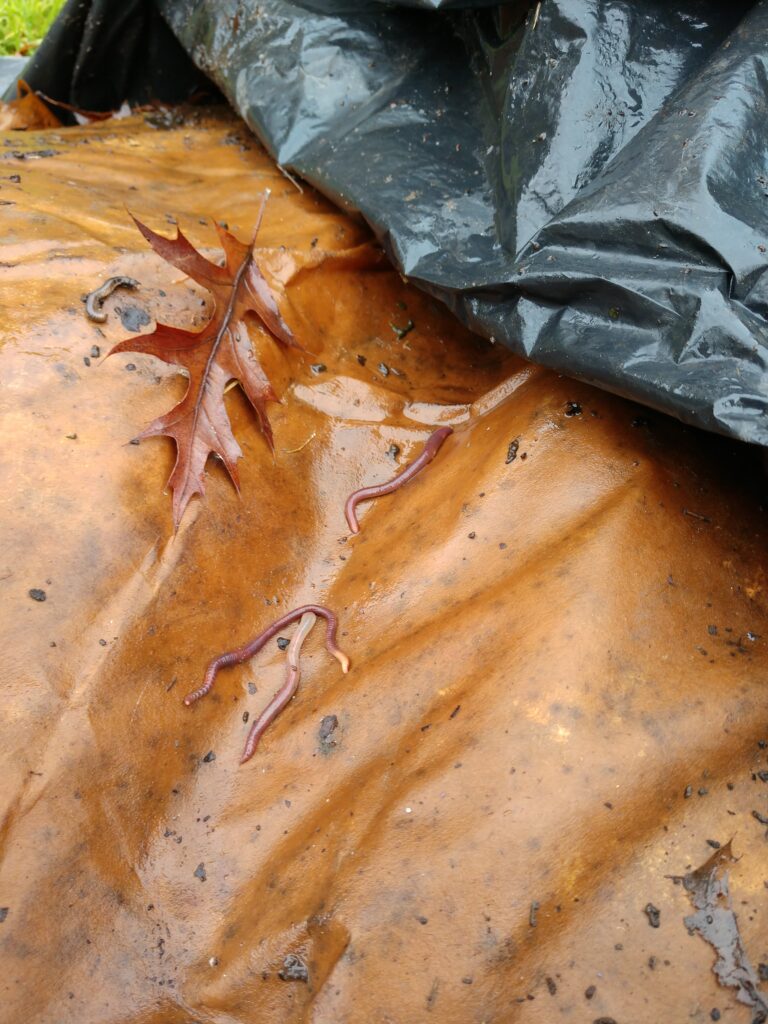
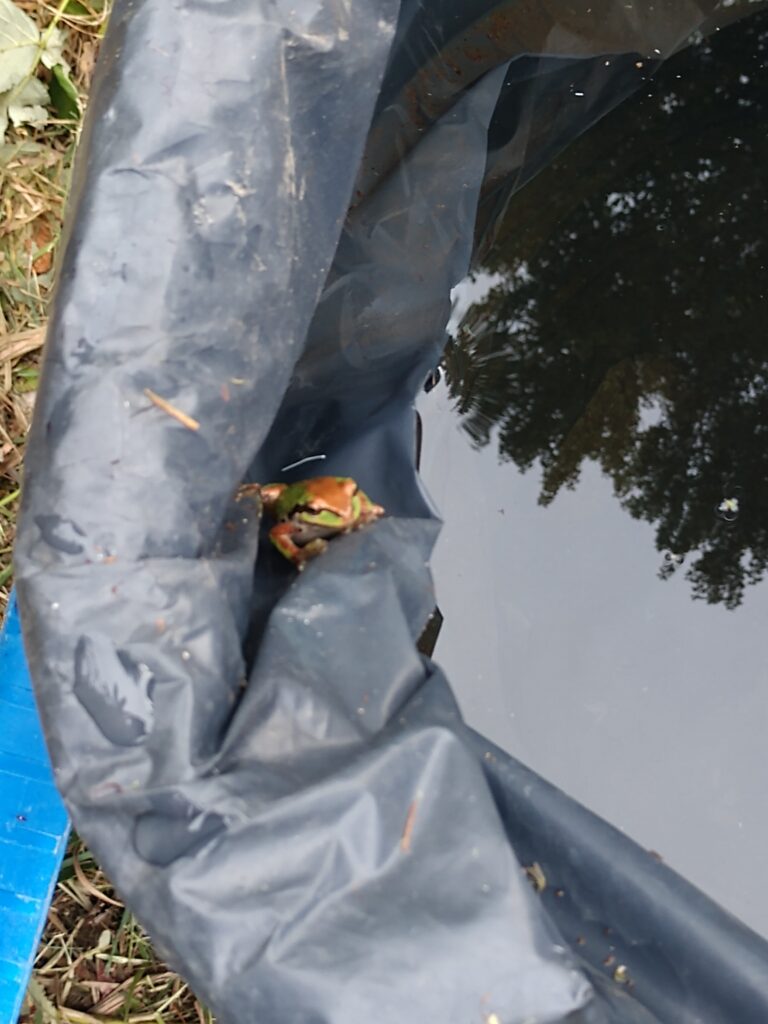
AUTUMN MOVEMENT by Carl Sandburg
I cried over beautiful things knowing no beautiful thing lasts.
The field of cornflower yellow is a scarf at the neck of the copper sunburned woman, the mother of the year, the taker of seeds.
The northwest wind comes and the yellow is torn full of holes, new beautiful things come in the first spit of snow on the northwest wind, and the old things go, not one lasts.


